Training Climbing Roses: ‘Try And Tie The Stems More Horizontally Than Vertically’

PERENNIALS > ROSES > TRAINING
Reviewed By COLIN SKELLY

Colin is a Horticulturist and Horticultural Consultant with experience in a range of practical and managerial roles across heritage, commercial and public horticulture. He holds the Royal Horticultural Society’s Master of Horticulture award and has a particular interest in horticultural ecology and naturalistic planting for habitat and climate resilience.
Contributions From PHILIP HARKNESS

With over 45 years as a Co-Owner of Harkness Roses, Philip has made a name for himself in the rose industry. His plant nursery won gold medals at the Chelsea Flower Show in 2021 and have bred various new roses, including ‘The Duke of Edinburgh’ rose, which was handed to the Late HRH Queen Elizabeth II to commemorate what would have been her late husband’s 100th birthday.
IN THIS GUIDE
For a full-on cottage garden effect your go-to plant should be a climbing rose.
These climbers are prized for being super-floriferous and a well-maintained mature specimen can be covered in blooms by the dozen.
Such a stare-worthy climbing rose doesn’t just happen by chance and some foresight, decision-making and training will be called for because, well, a climbing rose isn’t really a climber!
You have to make it into a climber and you do that by selectively pruning, trimming and training it, as Philip Harkness from Harkness Roses explains:
“Climbers need to be trained as well as pruned.
“Try to tie the stems more horizontally than vertically. A horizontal stem will generate lots of lateral flowering shoots along its length.
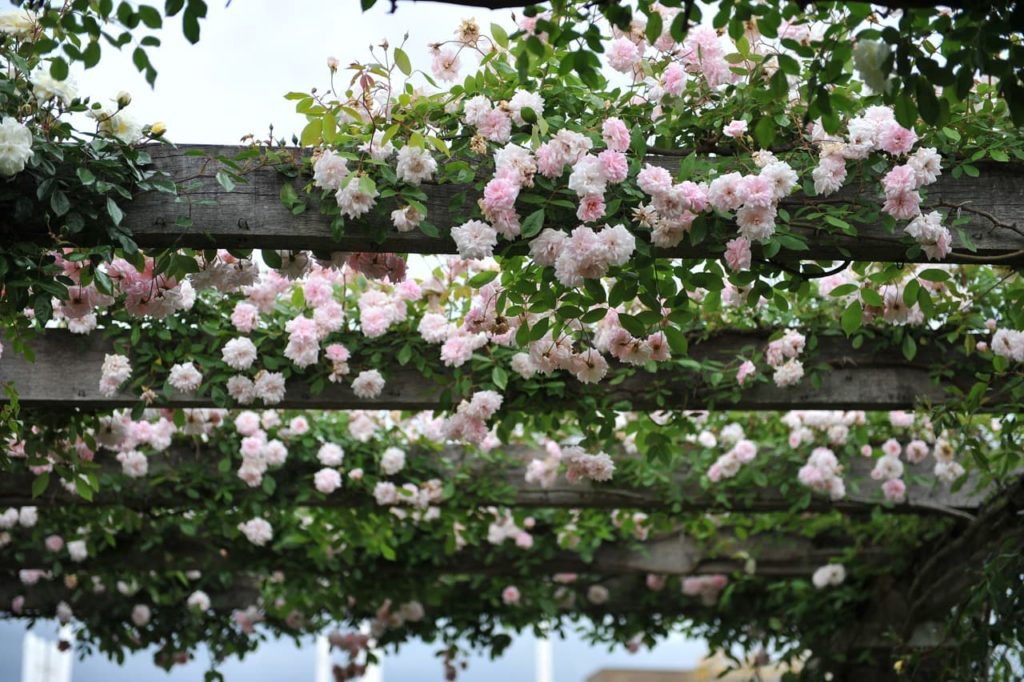
“You will be amazed how much you can bend the stems without breaking them. If they snap, fear not, make a clean cut and it will grow again next summer.”
Climbing roses do not have vines, suckers or tendrils and are actually similar to regular rose bushes in that they have canes, except their canes are much longer and are also more flexible.
They can easily be confused with rambling roses, with the main difference being that climbers have more of an upright and arcing habit, whereas ramblers have an overall spreading and sprawling growth pattern.
Climbing Roses are also distinguished by their repeated blooming.
| Difficulty | Hard |
| Equipment Required | Gardening gloves, goggles, pruning shears, fastening materials (as described) |
| When To Train | Main effort in winter, maintenance may be done any time of the year |
What Will Roses Climb On?
Training a climbing rose is similar to pruning a rose bush or a fruit tree as it too is a multi-year project.
So, just what will your rose be trained against?
Though it can be any type of structure that presents a tall enough vertical surface, some thought is required for good reasons.
An open structure will offer a convenient and readymade option, as the rose’s canes could be tied or fastened to its projections, uprights and crosswise elements.

Examples include a summer house, pergola, trellis or any other structure which has sides consisting of lattices, slats or grilles.
An unbroken surface, such as the wall of a house or a pillar, will not be as convenient and will require prepping.
If it is your first time growing a climbing rose, I’d recommend that you grow and train it against the former type of open structure.
Regardless of the type of support, it should be installed before the climbing rose is transplanted into the ground and cannot be installed later, as the risk of damage to the roots is too great.
Choosing The Right Support Structure
If you have a pre-existing structure on which you will grow and train a climbing rose, then choose a variety of a suitable size and vigour.
For example, if your structure is 5m tall, you probably don’t want a variety that will top out at about 3m.
Though any plant can regularly be pruned and trimmed to maintain a particular size, would anyone really want to grow ‘Climbing Madame Butterfly’, which sometimes reaches 6m in height, on a 3m lattice?

If you are enamoured with a particular variety of climbing rose, then select and install a support structure whose height and breadth will suit the size and vigour of that variety and avoid any more than a slight mismatch between the two.
Besides the size of the support structure, you’ll need to be very attentive to its strength and stability, as larger climbing roses eventually become very heavy and can put pressure on the structure.
A lightweight and small arbour framework may eventually collapse under the weight of a mature and bulky climbing rose, whilst a standalone trellis covered with a large variety could fall over on a blustery day.
If you intend to grow one of the bigger varieties, especially if you live in a region exposed to high winds, consider whether the support structure would show any sign of distress when your plant is fully grown.
Preliminary Prep Work
Whatever the structure, I’d recommend that you reinforce and anchor it into the ground if you intend to grow a large variety.
The most strong and secure structure is probably a boundary or dwelling wall and you can certainly grow and train a climbing rose against these, but you have to prep the wall first.
To do so, securely fasten a few lengths of smooth, PVC or vinyl-coated wire or stout fabric cord across the wall, spanning across the area on which you want to train the plant.
Do not use standard uncoated wire for climbing roses.
You can start with a few rungs, but you will need to keep stringing additional spans as the climbing rose gets taller.
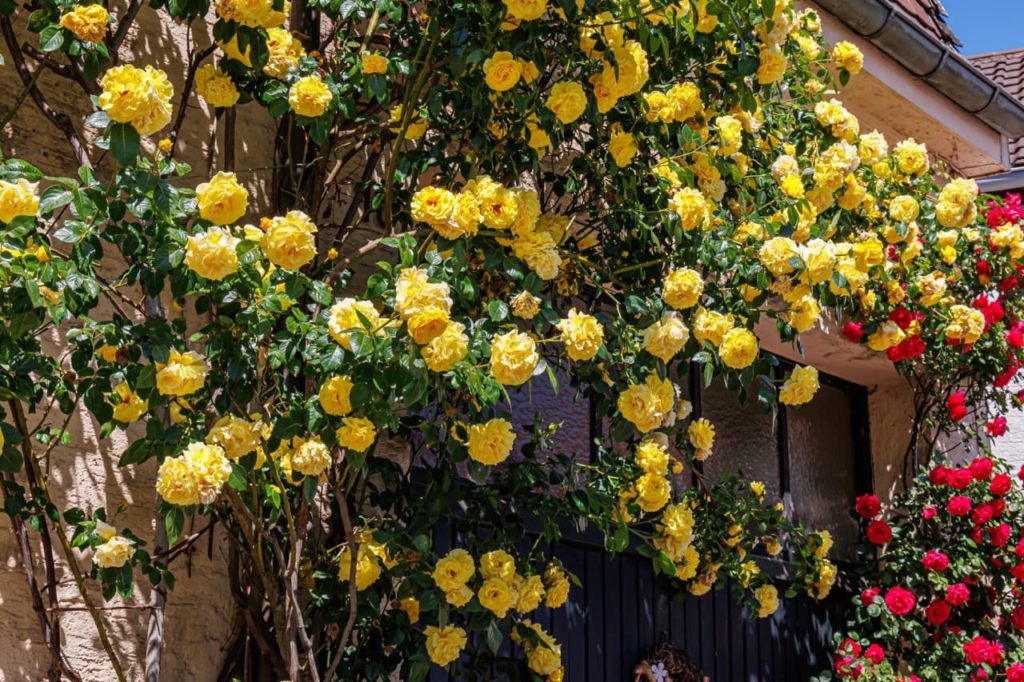
These wires or cords should be spaced about 30cm apart vertically and should not be tight against the wall, but semi-taut with a bit of give.
These rungs will be what you tie the canes to.
Canes are usually grown on and over these rungs, but you can pull them under and behind as well, two-for-one or alternating.
If you plan to train it on a pillar, wrap the pillar in PVC-coated or vinyl-coated wire mesh of the smallest gauge (or thickest wire) that you can find.
Alternatively, you can tie or tape the canes to the pillar, but this will not be as straightforward.
Selecting The Rose Canes
Transplant your climbing rose 20-30cm in front of the support structure.
Do not prune or train it during the first year; leave it to adapt to its new home and develop.
Depending on the initial size of the plant, you should start to prune and train it in the second or third year, though the second year is usually better.
The best season to prune and train is in spring, soon after fresh growth and new shoots emerge.
Though pruning is typically done once a year, it is perfectly possible, even preferable, to continue to train during the height of summer.
Select 5-6 canes to start with.
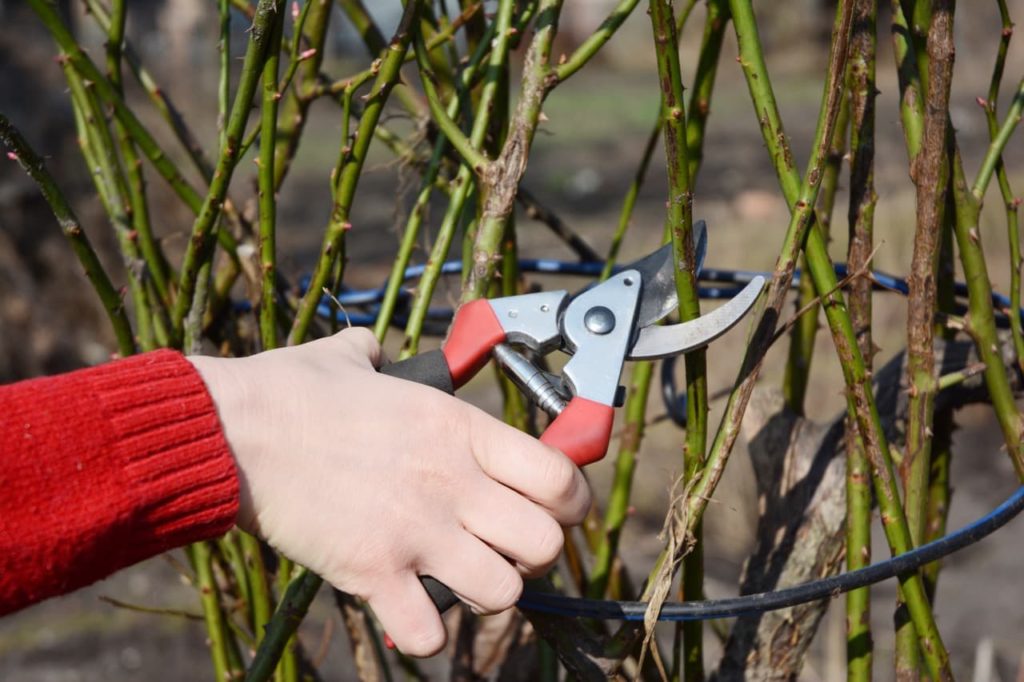
However, if your support structure happens to be a narrow, albeit sturdy, trellis or a pillar, then you would need to start with as few as three canes.
Select the strongest, longest, most vigorous and upward-growing canes.
Selected canes should be green and flexible and should not have become woody – these canes will make the best climbing simulators.
Prune weak, straggly and thin shoots and canes, as well as those that are growing outwards or sideways.
Be vigilant year-round for infected or diseased canes so that you can remove them ASAP (and arrange appropriate treatment for the entire plant).
Train The Canes In Winter
To train the canes, they have to be fastened on the support structure.
I strongly recommend using a good quality commercial garden tie wire.
Tape is fine, but after a while, it will look ragged and may start to come off after a couple of spells of heavy rain.
Gently pull the selected young canes in the desired direction over part of the support structure.
All canes should be trained in an upward direction but they need not be completely vertical – between 70° and vertical is the sweet spot for these origin canes.
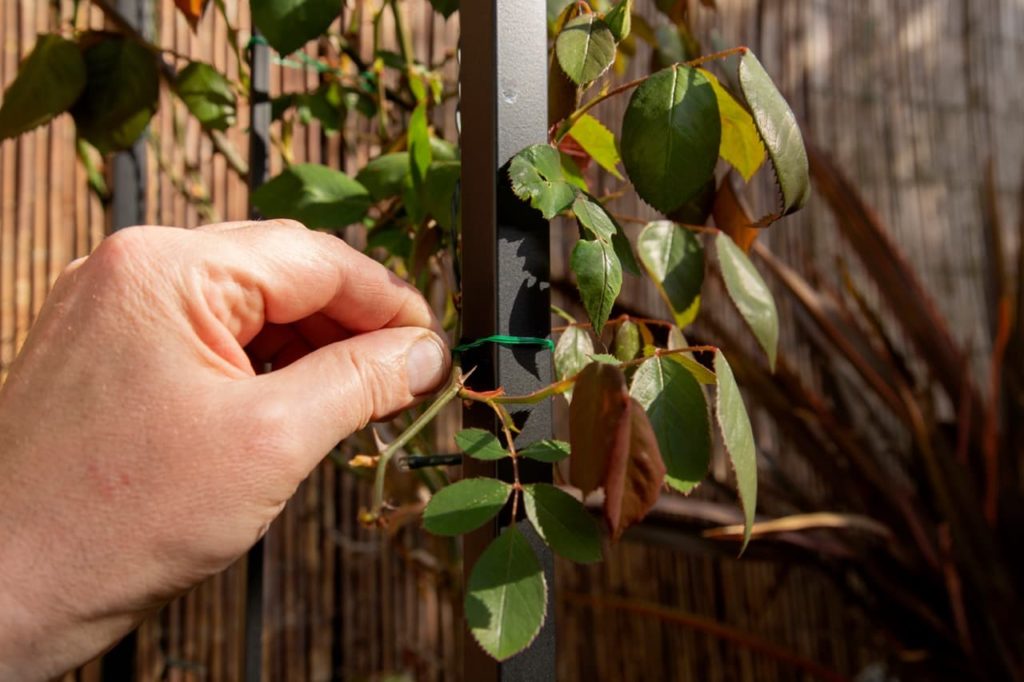
Take an appropriately-sized piece of tie wire and loop it around and through both the cane and the element, go round once more and then twist or tie it.
The length of the tie will depend on the thickness of the element the cane will be fastened to.
If it is cord or wire, 10cm will be quite enough, but if it is a section of trellis, a considerably longer length will be required.
The tie or tape should be tight enough to hold the cane in place but not so tight as to constrict or injure it.
A cane should be fastened in this way every 25cm.
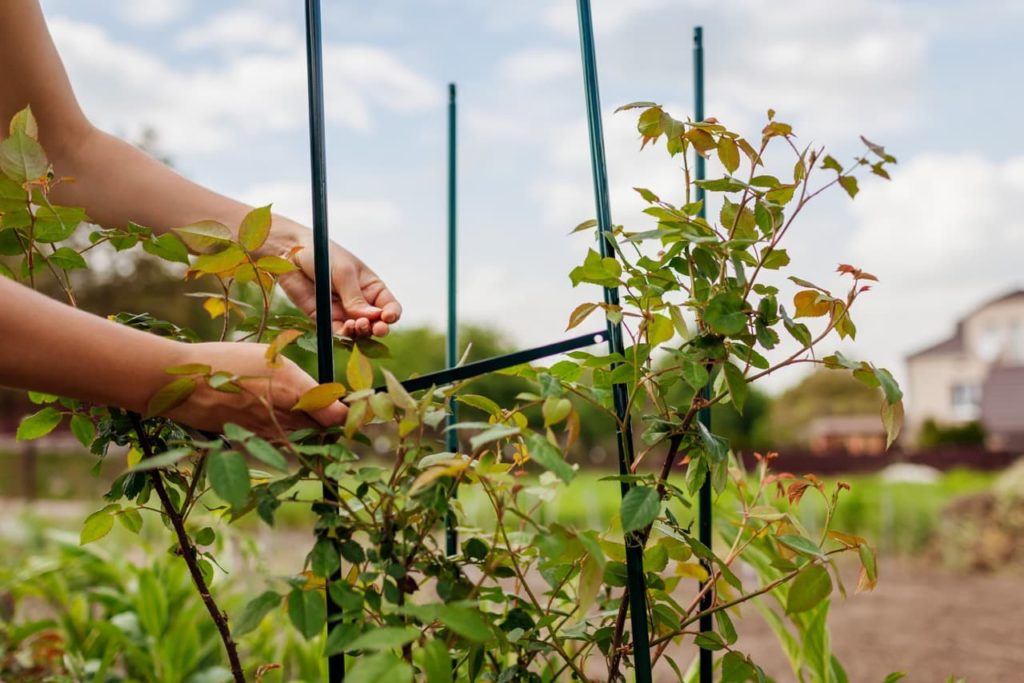
During the first year, you should need no more than two fasteners for most canes.
As for the distance between canes, this should be governed by how far apart the canes originate but you can fan them out depending on the size, especially width, of the structure.
You can allow one to rise vertically while training the adjacent one at an angle.
During the growing season, observe how the canes are developing.
If a cane has shot up and curled away, you may need to fasten it at a higher point, or if a cane’s growth has become weak and looks unhealthy, check for signs of abrasion or injury where you had fastened it.
Follow-Up Training
The following winter, select two or three new canes and fasten these as outlined above.
Prune any unneeded new canes.
“The bulk of climbing rose training is best carried in winter at the same time as pruning,” says Colin Skelly, a Master Horticulturist.
“Pruning and training are more easily carried out whilst stems are more visible when bare of leaves. Leaving until into the growing season risks damaging new growth and buds.”
The previously-selected canes will have developed branching shoots; these will also need to be selected or pruned.
Those that have emerged from the front side of a cane will almost surely need to go, along with those growing in undesirable directions that you deem untrainable.
If a selected branching shoot is about pencil-thick or thicker and 25cm or longer, then it should be trained and fastened.
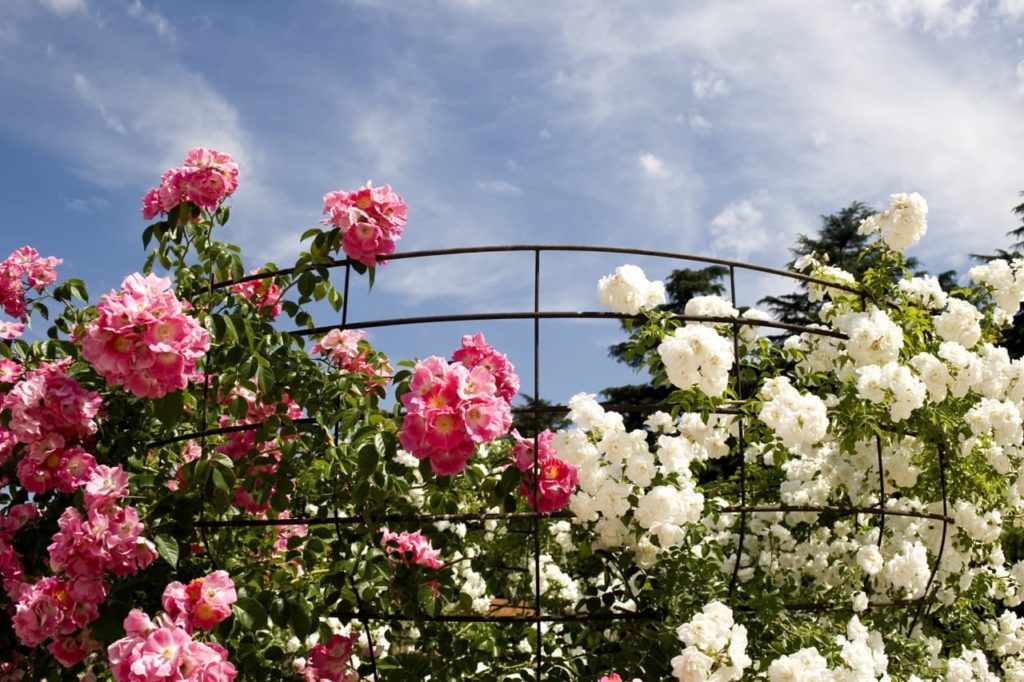
Any narrower or shorter, you can let it be.
Branching shoots of the appropriate thickness and length should be trained at an appropriate angle; anything from 45-75° will work very well.
Thereafter, if the number of trained canes and their selected branches suffices to completely cover the structure, prune new ones that arise.
Though training and fastening any cane’s growth spurt is an optional ongoing activity, training and fastening emergent growth is a mandatory spring task.
An already-trained cane should be fastened when it has grown 45-50cm from where it was previously fastened. Train and fasten such a cane near (but not at) the tip.
At the end of it all, your rose-climbing simulation should end up being spectacular!
Aftercare
Do keep checking all the ties or tape from time to time.
The loss of one fastener here and there will make no difference, but if multiple fasteners on the same cane fall off, it could result in canes falling from the support structure completely.
When a cane or a branch has reached the desired height or length on a structure, you will need to trim it and do so every season.
Keep in mind that if a cane reaches the top of a structure with a roof or horizontal section and the cane is still vigorous, you may well bend it and fasten it so that it then grows horizontally over the roof.

If the support structure is big and broad enough, you may not want to micro-manage your climbing rose after a few years, at which point you could allow nature to take its course.
“We should always try to work with nature, not against it,” says Philip.
“I still learn new things about roses every year. Each year is different, and every location has its own idiosyncrasies.
“Do what works for you, not what a book says you should do. Experiment, learn how different actions affect plants and connect with and be a part of the natural cycle in your garden.”
Who knows what kind of unexpected yet aesthetic growth pattern may eventually form?

